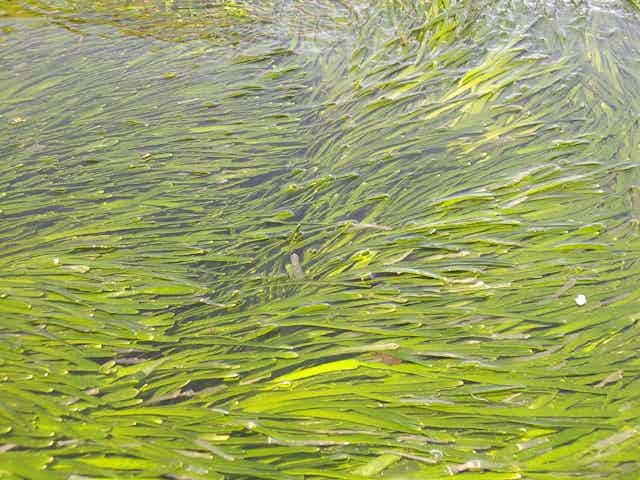Australia is surrounded by a thin green line of seagrass meadows potentially worth A$5.4 billion on international carbon markets, and which could contribute to Australia and other nations meeting carbon emissions targets. Whether that potential can be realised is very much dependent on the type of carbon management scheme our next government puts in place.
Most people are aware forests lock up carbon dioxide from the atmosphere. This is a part of our carbon accounting scheme and underpins tree-planting and forest conservation schemes, giving value to this “green carbon”. Until now, the carbon captured by marine plant systems, so-called “blue carbon”, has largely been ignored in carbon accounting.
But our new research from Edith Cowan University (published today in the journal PLOS ONE) shows that seagrass meadows, hidden beneath our oceans, lock away between four and ten times that of our forests. Pound-for-pound, they are big hitters when it comes to snatching carbon out of the atmosphere.
We conservatively estimate that Australia’s 92,500 sq km of seagrass meadows contain more than 155 million tonnes of carbon. At a carbon trading price of A$35 a tonne (predicted by the Federal Government for 2020) that indicates a multi-billion dollar asset that can be used for tradable carbon credits.
In addition to the carbon these meadows have already locked away, they add about another 1 million tonnes of carbon each year, with a potential value of $35 million.
So lets look at how we realise this potential value, and how the next government’s approach to carbon could affect this.
Under the past government’s policy, the price of carbon was fixed until 2014-15. After that the price would be determined by the market, in an emissions trading scheme. The estimate of A$5.4 billion is based on the past Government’s predicted carbon-trading price of A$35 a tonne in 2020.
Exactly how that would be realised remains unclear. However, mechanisms such as the UN’s Reducing Emissions from Deforestation and Forest Degradation program have been used internationally to realise the value of leaving forests intact so their stored carbon is preserved.
This sort of mechanism may create enormous flow-on benefits: jobs could be created in assessment of marine carbon resources, bringing these to markets or through the creation of new marine habitats through re-vegetation schemes.
Scientists and economists in the Mediterranean region are currently working together to develop tool kits that would allow blue carbon stores to be brought to the carbon market.
In contrast, the Direct Action Policy proposed by the current opposition, appears to severely limit the potential to realise the value of blue carbon.
Under a direct action scheme, there is no value associated with not leaving the carbon in the meadow, and no penalty for disturbing that meadow and releasing the carbon into the atmosphere.
Unfortunately, seagrass meadows are under serious threat from nutrient pollution and coastal development. Every square kilometre lost releases 1.6 tonnes of carbon back to the atmosphere.
One possible way that a Direct Action Policy could give value to blue carbon is by rewarding the creation of new vegetated marine habitat, in the way we pay for re-afforestation. Unfortunately, the biggest carbon stores are found in seagrasses which are notoriously difficult to transplant or revegetate.
There will need to be a massive investment if we hope to be able to do with marine plants what we have learned to do with forests over hundreds of years. In the short-term, conserving and valuing what we have might be the cleverer approach. If we lose the habitat it may well be a long-term loss, even if we are going to invest in transplanting.
Australia’s Coastal Carbon Biogeochemistry Cluster, a collaboration of research providers, is working to further improve our estimate of carbon stored in marine habitats and how these might change in future climate scenarios. Meanwhile, our European colleagues continue to investigate the ways in which blue carbon can be brought to the carbon market.
Hopefully, Australia will realise that we have a valuable blue carbon resource that is worth protecting and can be done so with economic benefit, if only we are open to creative carbon trading schemes.

